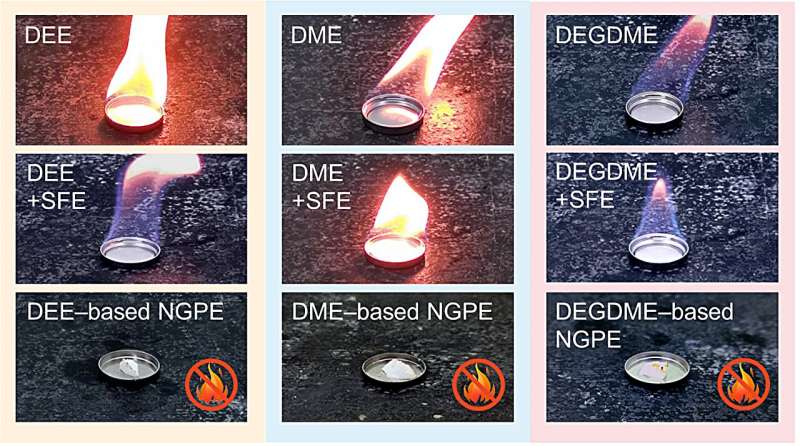September 27, 2023 feature
This article has been reviewed according to Science X's editorial process and policies. Editors have highlighted the following attributes while ensuring the content's credibility:
fact-checked
peer-reviewed publication
trusted source
proofread
Phosphazene-based electrolytes for high-voltage lithium batteries that work in extreme environments

Lithium metal batteries have numerous notable advantages over other existing battery systems, including high energy density. Nonetheless, the use of most existing high-energy lithium metal batteries in extreme environments is typically deemed unsafe or unfeasible, due to the volatility and flammability of their electrolytes.
Researchers at Bar-Ila University, University of Technology Sydney, CIC energiGUNE, and Tsinghua University recently set out to develop new electrolytes that could support the safe and stable operation of lithium metal batteries in a broader range of environmental conditions. These electrolytes, introduced in Nature Energy, were synthesized by using the fireproof phosphazene-derivative polymeric matrices.
"Replacing the graphitic anodes with metallic Li is considered a viable path to further increase the energy density of Lithium batteries," Professor Doron Aurbach, one of the researchers who carried out the study, told Tech Xplore.
"However, the growth of dendrites on Li anode during cycling triggers catastrophic safety hazards, which severely hinders their practical applications. To solve this issue, ether-based electrolytes have been widely employed in Li metal batteries because of their relatively low reactivity with Li metal."
Ether-based electrolyte solutions have a low viscosity and high ionic conductivity. These favorable properties can facilitate the rapid conduction of Li-ions and the exchange of interfacial charges in lithium batteries.
Ether-based electrolytes are also highly compatible with Li metal anodes, thus they can suppress the growth of dendrites while batteries are charging. Despite these advantages, many ether solvents are highly flammable, thus their use can greatly reduce the safety of battery cells.
"The low boiling points of ethers pose safety risks including fire, explosion, and liquid leakage," Doron said. "Besides, the insufficient oxidation stability of ether-based electrolytes may lead to uncontrollable solvent decomposition on the cathode surface at high voltage (>4 V vs. Li/Li+), greatly deteriorating the cyclability of high-voltage Li metal batteries."
In recent years, some research teams also introduced localized high-concentration electrolytes, which limit free solvent molecules in Li+ solvation structures. While these alternative electrolytes can reduce the time it takes to extinguish any fires that might arise, they do not fully eliminate the risk of fires or leakages.
"Polyphosphazene flame retardants with excellent flame-retardant effects have been widely used in the field of polymer flame retardants," Doron said. "Combined with localized high-concentration electrolytes, the hybrids of polyphosphazene can effectively improve the flame-retardant effect with low addition contents. And the safety of the full cells can be largely promoted."
In their recent paper, Professor Guoxiu Wang and their colleagues introduced a new versatile strategy to optimize ether-based electrolytes, preventing them from catching fire or leaking while also improving their compatibility with electrodes. This strategy entails a co-solvent and gelation treatment using butenoxycyclotriphosphazene (BCPN) monomers.
"To solve the inherent disadvantages of flammability and poor oxidation stability for ether-based electrolyte, fluoromethyl 1,1,1,3,3,3-hexafluoroisopropyl ether (SFE) was introduced as a co-solvent (served as an anti-solvent) with an ether solvent to improve the oxidation resistance and cathodes' stability," Wang said. "Then, these binary electrolytes were gelled in situ by polymerization of BCPN monomers to achieve flame retardancy and interfacial compatibility."
In initial tests, Wang and his collaborator Dr. Dong Zhou found that their proposed treatment using fluorinated co-solvent and fireproof polymetric matrices fully eliminated risks of fire and electrolyte leakage in lithium metal batteries. The team were also able to achieve electrolytes that are highly compatible with high-energy cathodes using a carefully designed Li+ solvation sheath, along with the BCPN-derived protective surface films formed on the cathodes.
"We manufactured high-energy-density Li||NCM811 batteries using our gel electrolyte and these batteries achieved high-capacity retention, superior low-temperature performance, good cyclability under high pressure and steady power supply under abusive conditions," Dr. Dong Zhou said. "We successfully solved the safety problem for high-energy lithium metal batteries."
The recent work by this team of researchers could have important implications for the development of next-generation lithium batteries. The electrolytes introduced in Nature Energy and their underpinning design strategy could soon open a new path for fabricating high energy, durable and safely rechargeable Li metal batteries that can operate in extreme environments.
"In our next studies, we intend to continue our research on improving battery safety and low temperature performance, which would help to expand the extreme environment application of high energy density batteries, for instance allowing their integration in aerospace vehicles, submarines and polar region devices," Wang added.
More information: Yuefeng Meng et al, Designing phosphazene-derivative electrolyte matrices to enable high-voltage lithium metal batteries for extreme working conditions, Nature Energy (2023). DOI: 10.1038/s41560-023-01339-z
© 2023 Science X Network


















